If you’re a history enthusiast, an archeology lover, or simply someone who appreciates the rich cultural heritage of ancient civilisations, Turkey is a treasure trove waiting to be explored. From majestic temples to Grand Roman theatres, this fascinating country offers a plethora of ancient ruins that will transport you back in time.
Turkey’s ancient ruins are scattered across the length of the country, from Istanbul in the west to the border with Armenia in the east. There are historical sites from every era of civilisation and fine architectural examples from many of the most important empires.
From running Istanbul to Cappadocia tours on overland expeditions, to exploring eastern Turkey by campervan, to living part-time near the Turquoise Coast, I’ve been lucky enough explore many of the historical ruins in Turkey.
In this article, I share some of the most remarkable ancient sites in Turkey, providing valuable insights and insider tips along the way.
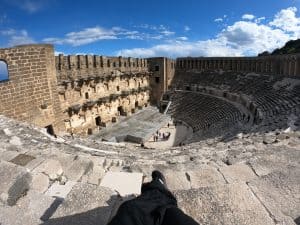
Disclaimer: Some links in this article are affiliate links, which means that if you purchase through them I receive a small commission, at no extra cost to you. This helps cover the cost of running this blog. Thanks for your support!
Top Ancient Sites in Turkey Map
The Best Ancient Ruins in Turkey
Turkey has such an abundance of archaeological sites, it’s hard to narrow them down to a manageable list. There are certainly many more sites that I could have included here.
I’ve compiled the sites in no particular order and which ones to include on your trip will likely be decided by the region of Turkey you are visiting.
Use the map above to see all of the sites together or alternatively use the pinned locations on the link at the end of each section.
1. Göbekli Tepe
Redefining History
Top of the list and Turkey’s most important ancient site, if not the world’s, is Göbekli Tepe. This truly ancient Turkish ruin has altered what archeologists believe to be the origins of human civilisation.
It has generally been accepted that the earliest urban settlements developed between 4000 and 3000 BC, however the temples at Göbekli Tepe date back to 9000 BC. That’s much older than the Pyramids in Egypt or even Stonehenge in England.
Archaeologists believed humans to be hunter gathers at this date, however the presence of a temple suggests there must have some sort of settlement nearby which thereby infers agriculture was taking place.
More excavations are being carried out at other nearby sites such as Sefer Tepe, Hamzan Tepe and Karahan Tepe, which they believe is even older!
The ruins at Göbekli Tepe are on display at several pits where you can appreciate the carved temple pillars from above. Look closely to appreciate the carvings on the world’s oldest known megaliths. There is a small but informative museum on site which helps to explain the findings so far, along with a stunning audio visual display.
The impressive Archaeological Museum in nearby Sanliurfa holds many of the artefacts found at Göbekli Tepe and other similar sites in the area, and is a must-visit.
Göbekli Tepe is located in the Southeastern Anatolia region of Turkey, close to Sanliurfa.
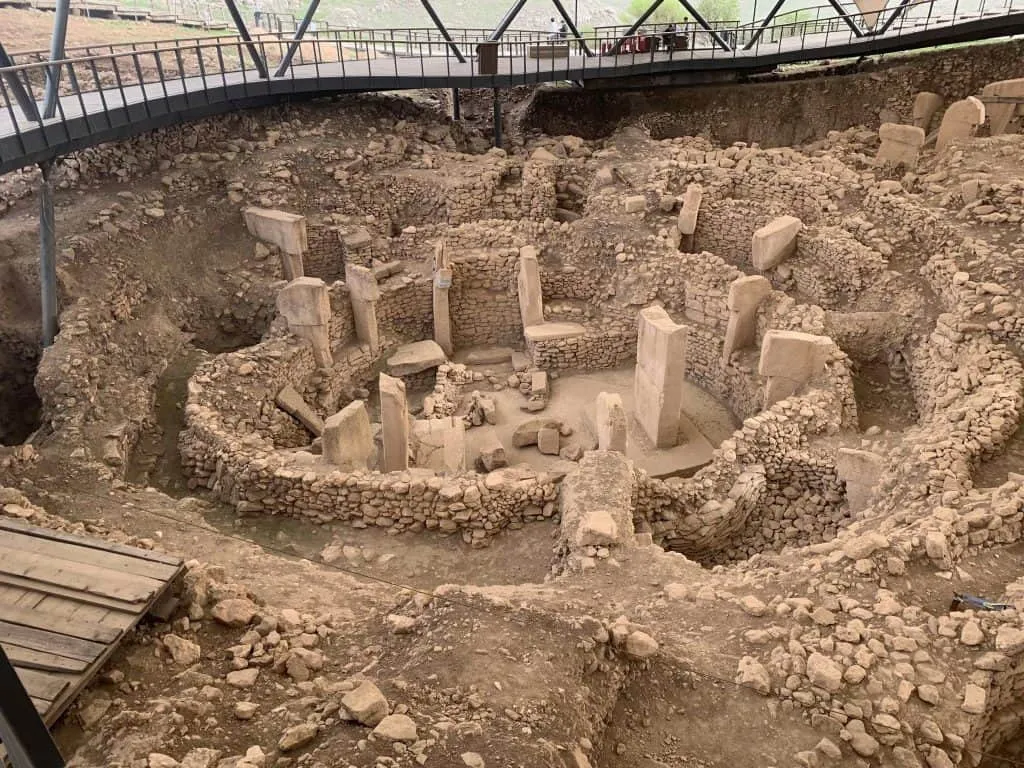
2. Ephesus
The Greatest Roman City Outside of Rome
Next on the list is the mighty Ephesus, an awe-inspiring ancient city that was once the capital of Roman Asia Minor and the most thriving city of the Roman empire outside of Rome itself.
Located near present-day Selçuk, this archaeological wonder is home to an array of well-preserved structures that offer glimpses into the grandeur of the Roman Empire. As you stroll down the marble-paved streets, you’ll encounter the iconic Library of Celsus which was originally constructed around 125 AD and more recently renovated in the 1970s.
Meanwhile, in lower Ephesus the Great Theatre was the largest theatre in the ancient world and its size is honestly staggering. Other sites to visit at Ephesus include the Odeon, the Temple of Hadrian and the covered terrace houses (for an extra fee).
In the absence of a guide or if visiting solo, the audio guide is well worth the extra fee. They can be picked up at the entrance, with a form of ID required as a deposit. There are two entrances to Ephesus, an upper gate and a lower gate, so just be mindful of this if you do use an audio guide as it will need to be returned to the same gate.
Ephesus is located near the modern day city of Selçuk and one of many archaeological sites located in this region of Turkey.
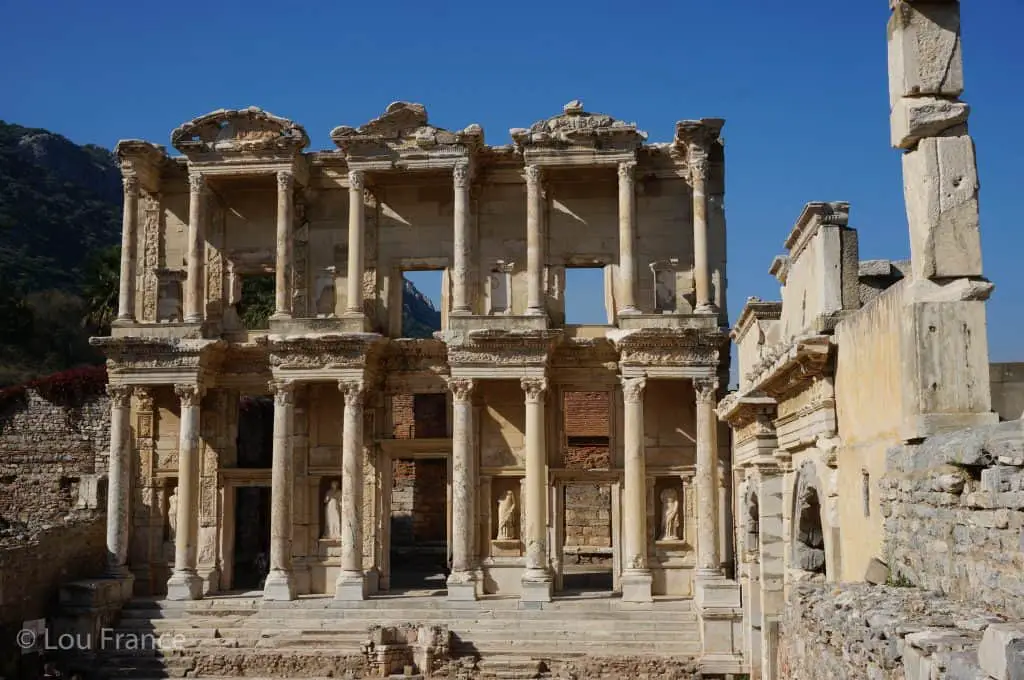
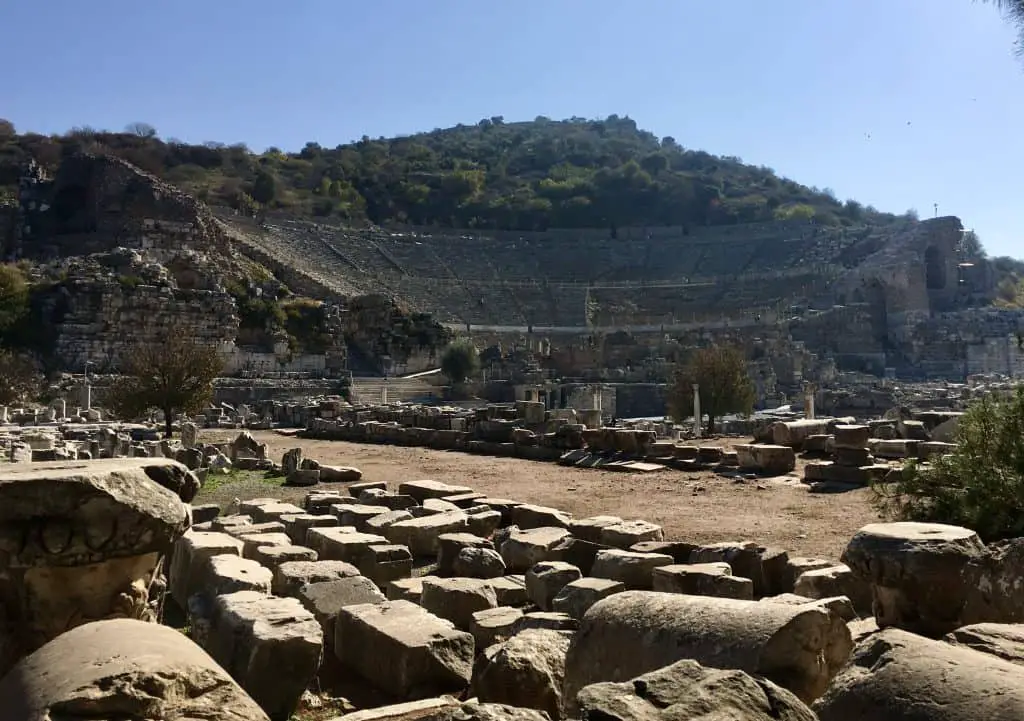
3. Hierapolis-Pamukkale
Nature’s Masterpiece and Ancient Spa
Next is one of Turkey’s most visited destinations. The mesmerising site of Hierapolis-Pamukkale is a unique blend of natural wonders and ancient ruins. Pamukkale, meaning “Cotton Castle” in Turkish, is renowned for its striking white terraces formed by mineral-rich thermal waters cascading down the hillside. Indeed, the thermal waters of Pamukkale have been enjoyed for their therapeutic properties since ancient times.
Atop this stunning landscape lies the ancient city of Hierapolis, which was inscribed on the UNESCO World Heritage List in 1988. Hierapolis was originally built in 200 BC by Eumenes II in dedication to the Amazon Queen Hiera, however most of what can be seen today reflects the Roman inhabitance.
At Hierapolis admire the well-preserved Roman theatre, the enchanting necropolis, and visit the museum which is located in an old Roman shower house. If you want to bathe in the healing waters just as the Romans did, be sure to take a dip in Cleopatra’s pool for an extra fee.
Hierapolis – Pamukkale is located in the province of Denizli in southwestern Turkey. It can be visited on a day trip from Izmir or a day trip from Antalya.
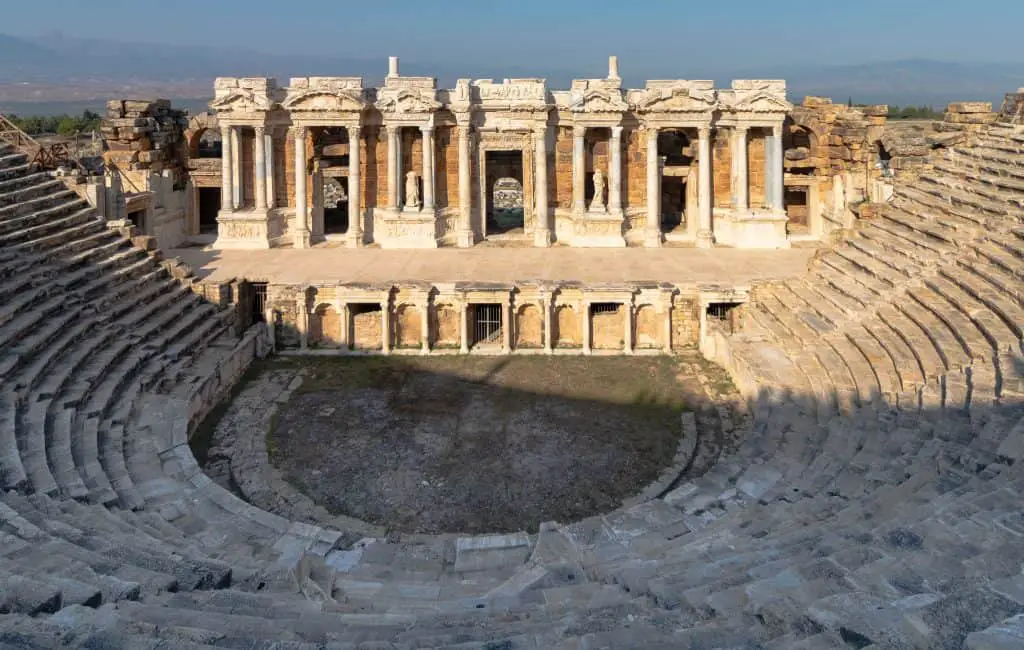

4. Troy
Unveiling the Legend of the Trojan War
Traveling further back in time, we arrive at the legendary city of Troy, immortalised in Homer’s epic poem, the Iliad. Steeped in myth and history, Troy invites you to unravel the tales of the Trojan War and discover the remnants of this ancient citadel.
Although much of Troy lies in ruin there is still much to explore. Wander the ruins of defensive walls, explore the ancient houses, and visit the famous reconstructed wooden horse that played a pivotal role in the fall of Troy.
I strongly recommend hiring a guide for your visit to Troy in order to bring the site alive and truly appreciate its history. Without a guide there really isn’t a whole lot to see at Troy. Audio guides are also available at the entrance gate for a small fee and be sure to visit the nearby archaeological museum during your trip.
Troy is located in northwest Turkey, near the city of Çanakkale. It’s a great stop to include on a Turkish road trip from Istanbul to Cappadocia.
→Troy
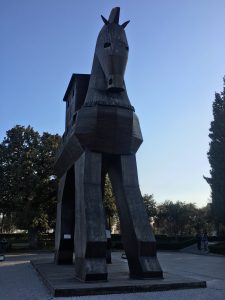
5. Pergamon
A Cultural Hub of Antiquity
Pergamon was a once-flourishing cultural centre of the Hellenistic period. Perched on a hilltop overlooking the modern town of Bergama, Pergamon offers panoramic views and an extraordinary collection of archaeological wonders.
A cable car can take you to the top of the ruins but be sure to explore more of this vast site, including the houses that contain well-preserved mosaics.
The stunning theatre of Pergamon is the steepest of any in Turkey and provides fabulous views over the city below. The Asklepion, an ancient medical centre dedicated to the Greek god of healing, Asclepius, is also worth exploring.
Pergamon is located in northwestern Anatolia, in the province of Izmir.
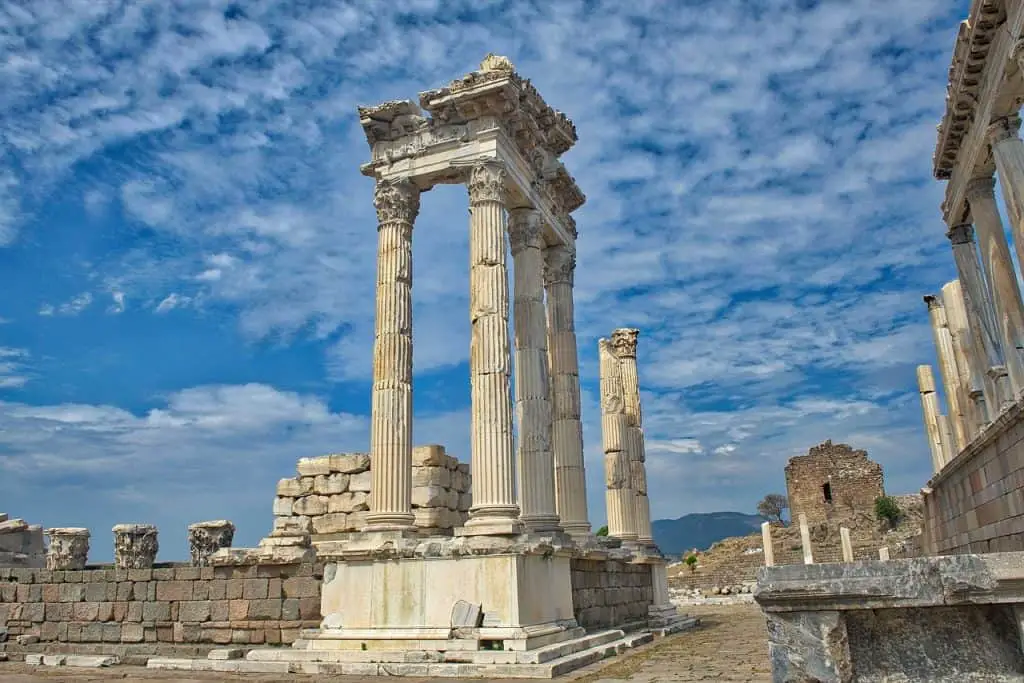
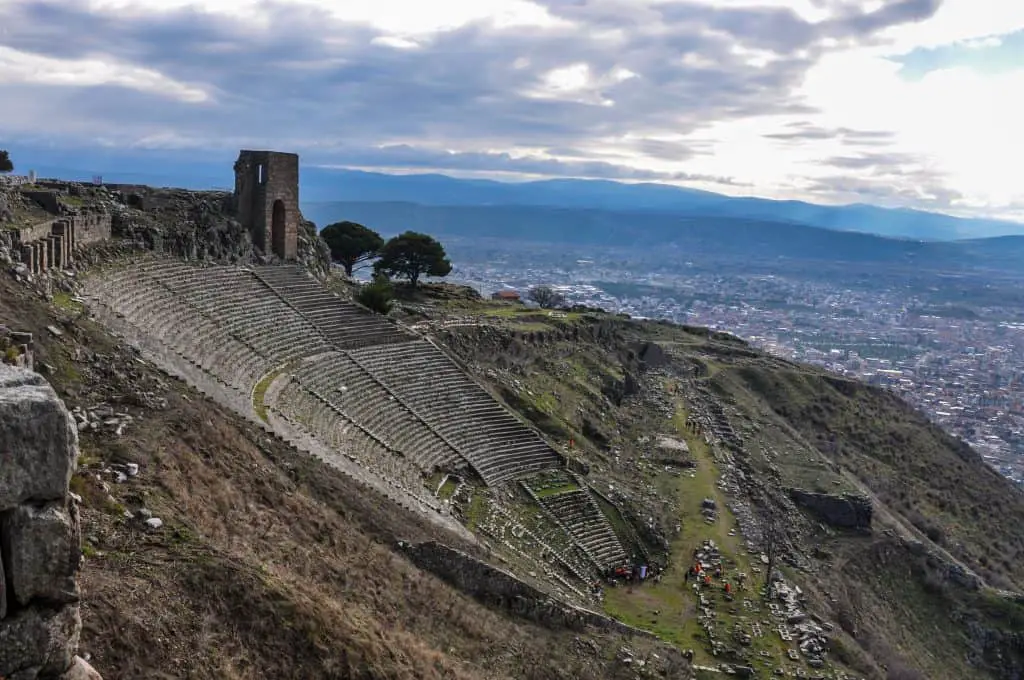
6. Hattusha
The City of a Thousand Gods
Venture off the beaten path and discover Hattusha, the ancient capital of the Hittite Empire. This archaeological site unveils the remnants of a powerful civilisation that flourished over 3,000 years ago. Today this UNESCO listed ancient city is an open-air museum consisting of two large sites.
At these sites, explore the imposing Lion Gate, wander through the Palace Complex and under the 70 metre long Yerkapı tunnel, before marvelling at the ancient reliefs that depict scenes of battle and mythology. Hattusha offers a glimpse into a lesser-known chapter of ancient Turkish history.
Hattusha is located in Çorum Province in central Turkey.
7. Kekova Sunken City
Lost to the Waves
Dolchiste is an ancient Lycian settlement off the island of Kekova, near the pretty town of Kas. Following an earthquake in the 2nd century, the ancient city has been engulfed by the sea. Since the whole area is now protected it’s not possible to swim amongst the ruins, however boat trips and kayaking tours offer visitors the chance gaze through the turquoise waters at the ruins that lie below.
The ability to kayak over and amongst ancient tombs makes this site a unique addition to this list. Whilst exploring this ancient city, take time to get lost in nearby Simena. This ancient city sits on a hillside peninsula opposite Kekova Island and is well worth exploring.
Hike to the top of the hillside to explore Simena Castle and admire fabulous views over the Turquoise Coast. Walk along the peninsula to explore more tombs and enjoy fresh seafood at one of the local restaurants that make up the modern day village of Simena.
Kekova is located in the Antalya Province and can be visited on a day trip from Kas.
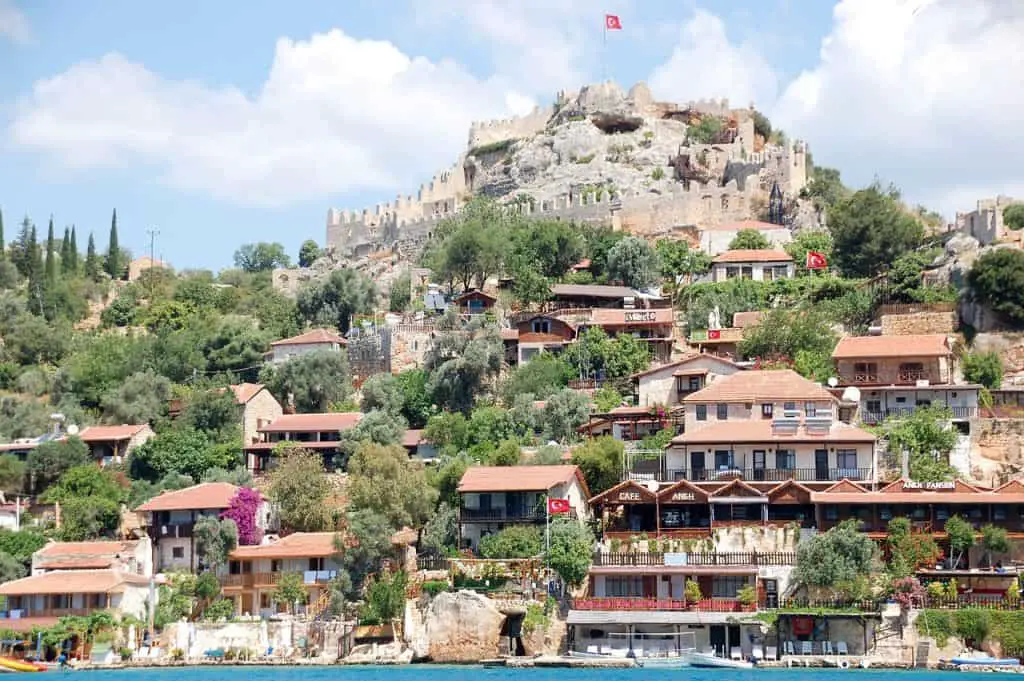
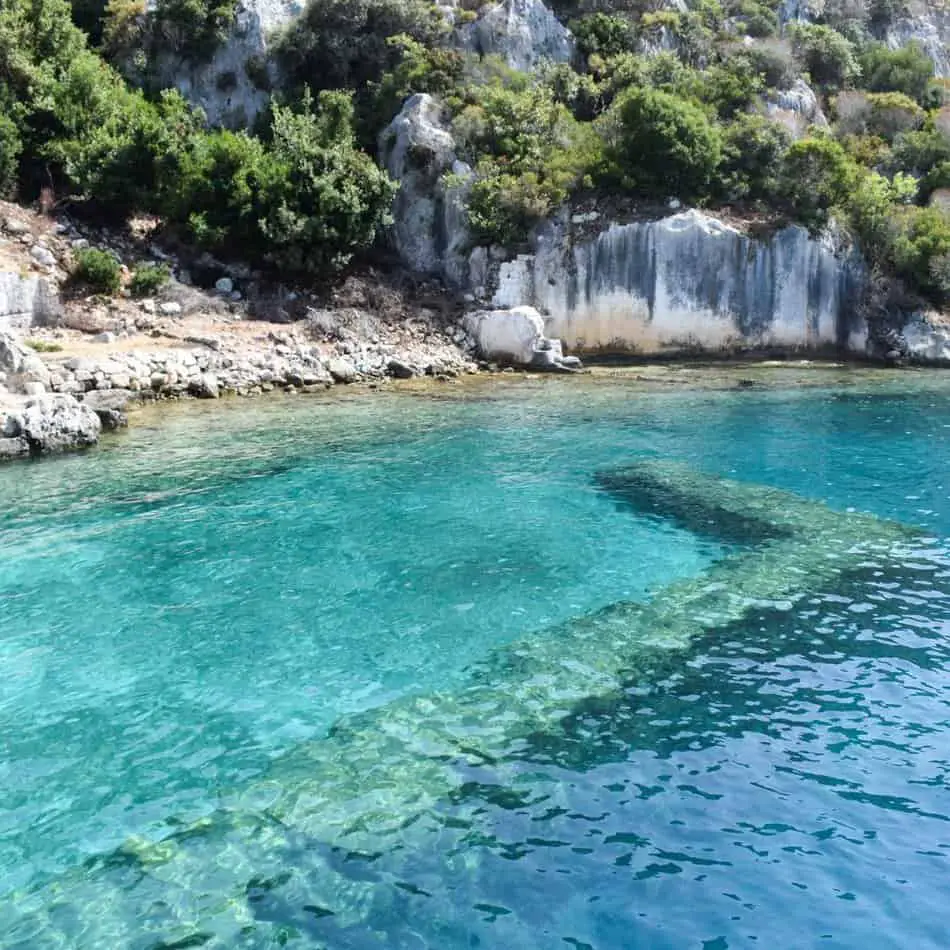
8. Xanthos
The Capital City of Lycia
Xanthos is an ancient Lycian city located in the Fethiye district of Turkey. Situated on a hill on the banks of the river Xanthos, this important Turkish ruin was the capital city of the Lycian civilisation. Xanthos has many remarkably well-preserved ruins, including an agora, a theatre and a colonnaded street which still has grooves left by Roman chariots.
The Xanthian Obelisk found close to the theatre, is a huge pilar covered with the longest Lycian inscription known to exist. I was fascinated by this pilar and spent an age studying the 250 lines of unique Lycian scripture!
Another notable structure on the site is the Xanthos Necropolis. This is a complex of tombs with intricate designs, some dating back to 500 BC. The most notable of which is the Harpy Tomb which has the carvings of two birds believed to be mythical harpies. Visitors can explore the necropolis and find out more about Lycian culture and architecture.
Xanthos is located in the Antalya Province, just one hour from Fethiye. Discover all the best things to do in Fethiye in this guide.
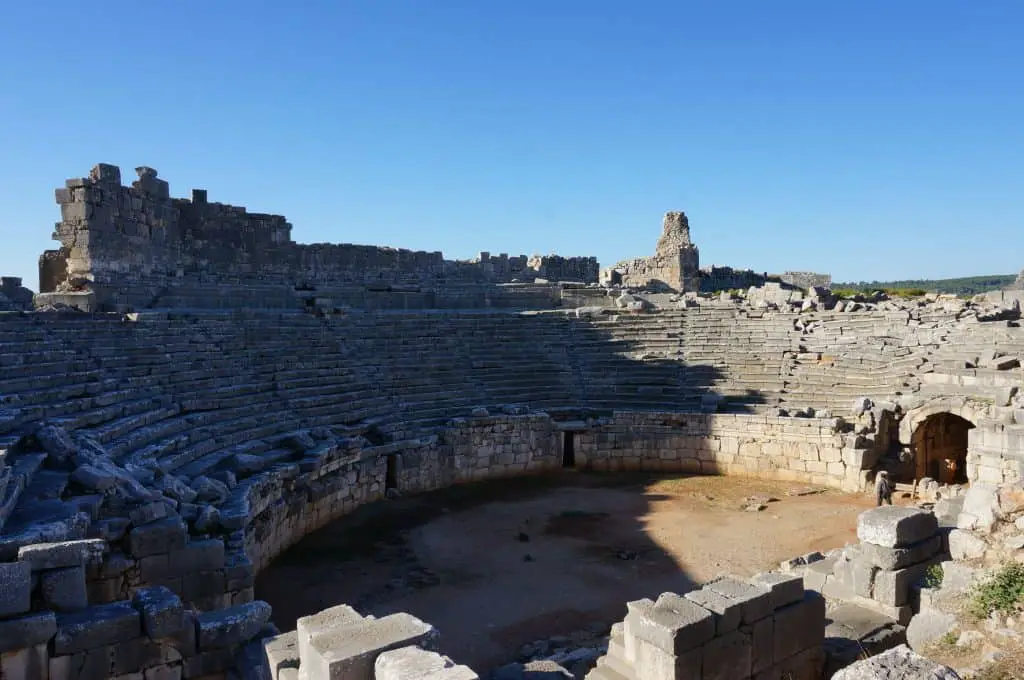
9. Letoon
The Religious Centre of Lycia
If Xanthos was the political centre of the Lycian civilisation, then nearby Letoon was the religious centre. Letoon consists of three temples dedicated to the Lycian gods, Leto, Artemis and Apollo. The site is a mix of Hellenistic and Lycian architecture. You can explore the ruins of the city, including tombs and courtyards, as well as the main temples.
The most famous temple is dedicated to Leto, the mother of the twins Artemis and Apollo. It contains an altar, an odeon, and a podium with carved reliefs depicting scenes from Greek mythology. Letoon is a very small ancient site compared to others in the area. Other highlights include a sacred spring, where sacrifices were once made, and a small but intact theatre.
Letoon is located in the Fethiye district of Muğla, just 4 kilometres south of Xanthos. Letoon and Xanthos can be easily combined on a day trip from Fethiye.
10. The Underground Cities of Cappadocia
Underground Life
There are 36 underground cities to explore around the other worldly landscape of Cappadocia, some of which were excavated as early as the Hittite period. Not all of the cities are open to the public but two of the largest to visit are Derinkuyu and Kaymakli.
It’s thought that these underground cities offered protection from foreign invaders. The cities have a multitude of rooms and spaces including kitchens, stables, churches and, of course, wine cellars.
The Derinkuyu, which is another UNESCO World Heritage site, is the bigger of the cities and the deepest underground city in all of Turkey. It is an impressive feat of engineering and is a fascinating place to explore.
Kaymakli was built under the Citadel of Kaymakli in the 7th and 8th centuries BCE. The tunnels in Kaymakli are low and steep and provides a true feeling of being deep underground.
Both cities can be visited by public transport from Nevşehir and are visited on tours from the popular tourist hub of Göreme. The underground cities are a must on any Cappadocia itinerary.
Cappadocia is located in central Turkey. For all the best things to do in Cappadocia, read this guide.
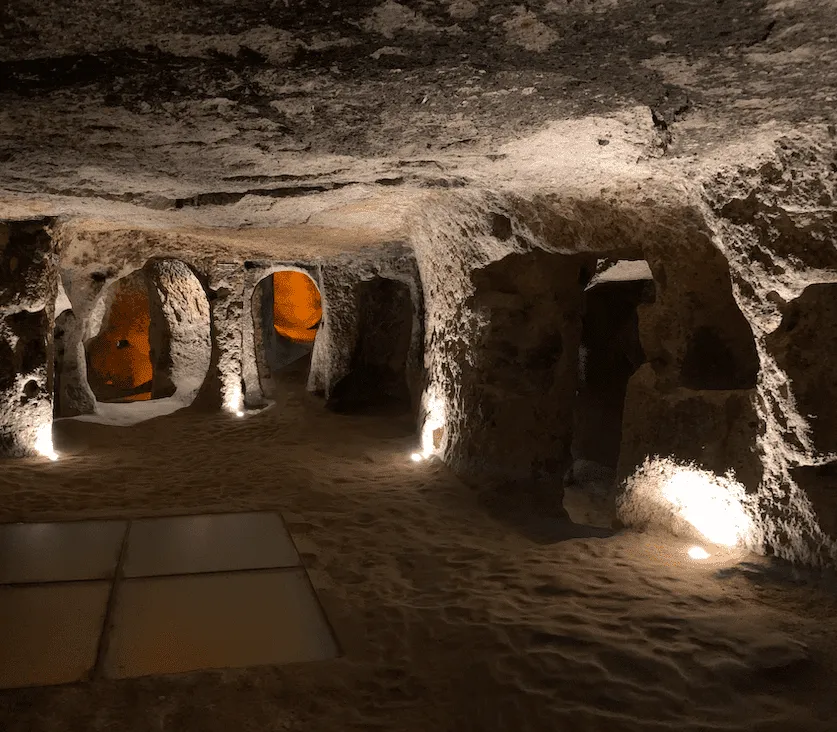
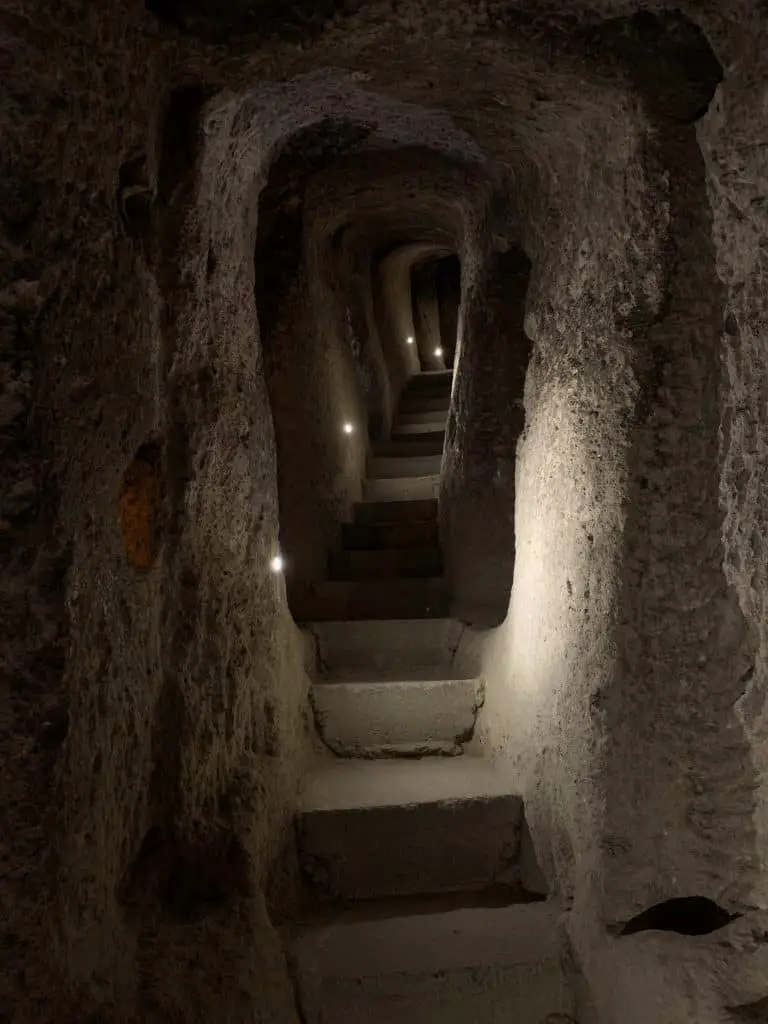
Related Reading
11. Side
A Gem on the Mediterranean Coast
Located 73km to the east of Antalya, you can find the Greco-Roman harbour city of Side. Side was one of the most important cities of Pamphylia, believed to have origins in the Bronze Age. Today, the ancient city and modern town co-exist with historical sites laying side by side or underneath houses, restaurants and shops.
Most of the locations are free to enter, with the exception of the large, 2nd century amphitheatre. Take time to appreciate the well-preserved Hellenistic main gate as you enter the city, be sure to walk out to the peninsula to visit the Temple of Apollo and Athena and get lost amongst the temples and agora located next to the theatre.
Side is located in Antalya province and offers a great day trip to add to your Antalya bucket list. Side can be combined with a trip to nearby Aspendos.
→Side
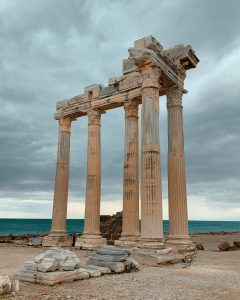
12. Patara
An Ancient Ruin for the Beach Lovers
Patara is an ancient city that was once a major port in the Lycian region and today is listed as a UNESCO World Heritage Site. Originally founded by the Lycians, Patara was ruled by various civilisations from the Persians to the Greeks to the Romans, before sand silted up the port in the 16th century.
When visiting Patara, you can explore the remains of a bath complex, a fairly intact theatre and a restored council chamber where Lycian leaders met to debate important matters of the region.
The city sits behind the sand dunes of Patara beach, which is home to the longest stretch of sand in all of Turkey. On the beach there are plenty of restaurants to buy food and drinks and sun loungers for hire. Patara beach is also an important nesting ground for Loggerhead turtles so access to beach is forbidden at night.
Entrance to the city and beach are included on the same entrance fee.
Patara is located along the Turquoise Coast in Antalya province and is a popular thing to do in Ölüdeniz.
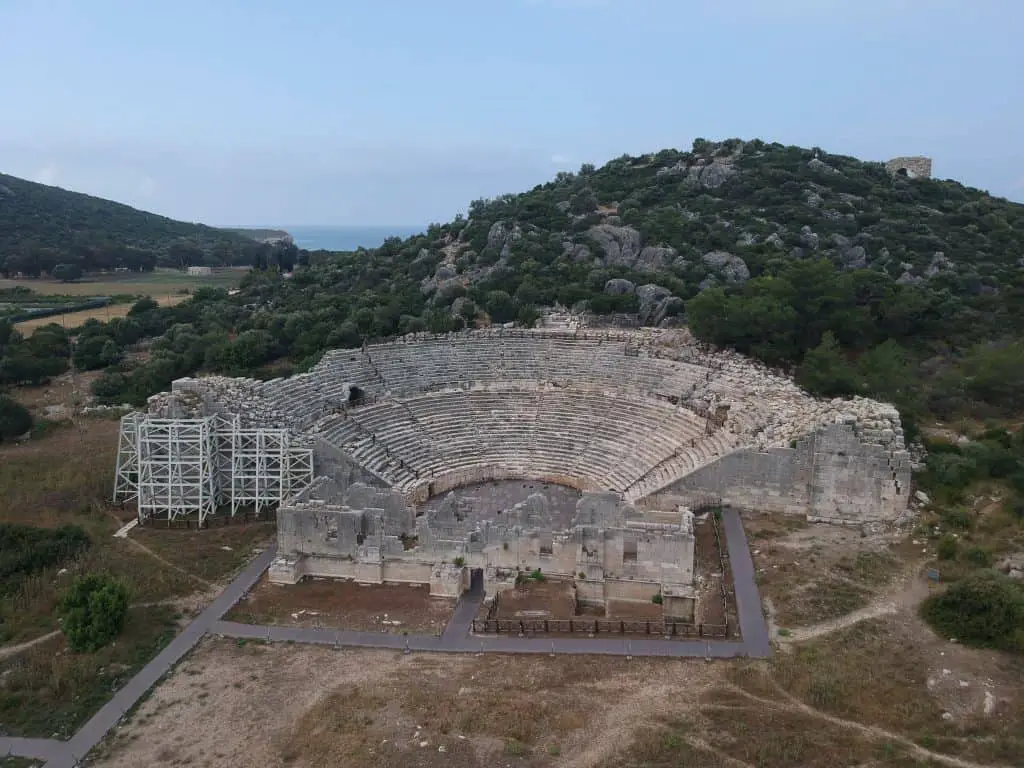
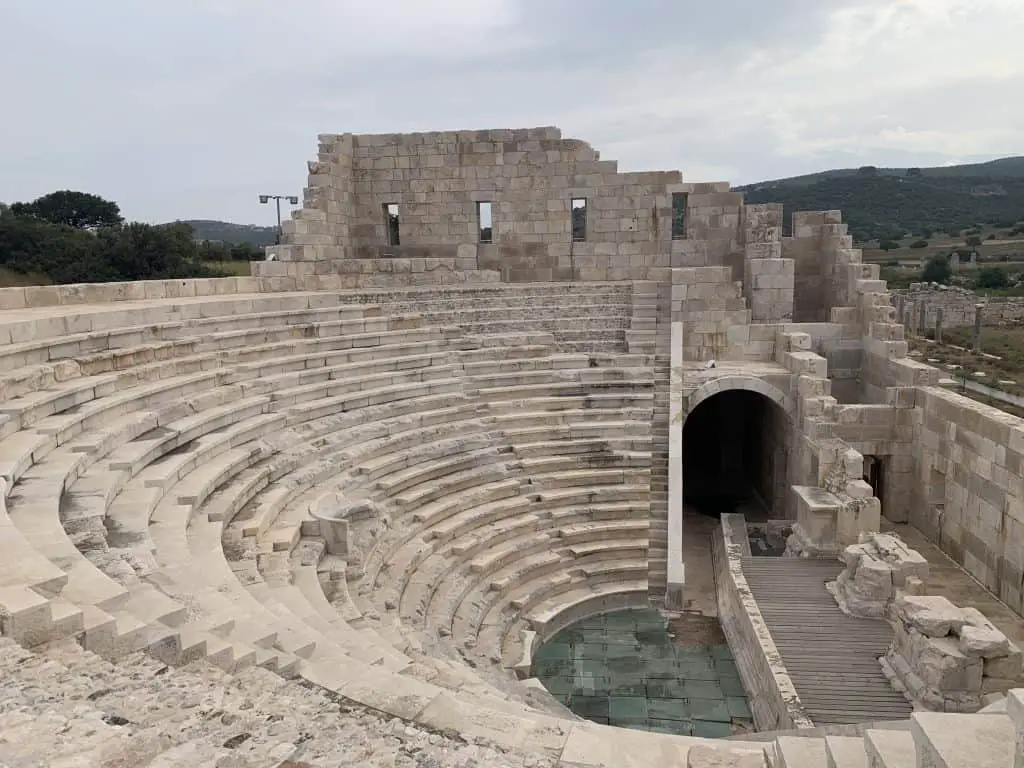
13. Nemrut Daği
The Gem of the East
Deep in the heart of Central Anatolia sits one of the most unique ancient sites of Turkey. The iconic heads of Nemrut Daği are as spectacular as they mysterious and are a top inclusion on any visit to Turkey.
Nemrut Daği (Turkish for Mount Nemrut) refers both to the mountain and the UNESCO listed archaeological site that sits at the top. There are two sets of statues set on terraces which were constructed either side of a burial mound. The seated statues represent Grecco-Persian gods and were constructed by King Antochus Theos of Commagene in the 1st century BC.
A 20 minute hike is required to visit this unique monument and at 2134m it can certainly take your breath away. The easiest way to visit Nemrut Daği is by a guided tour although it is possible to visit independently. There is no public transport to the site so private shuttles or a rental car is the best option. If you plan to rent a car in Turkey, read this article about driving in Turkey.
Nemrut Daği is located in Adiyaman Province, southeastern Turkey. Learn more about how to visit Nemrut Daği, in this guide.
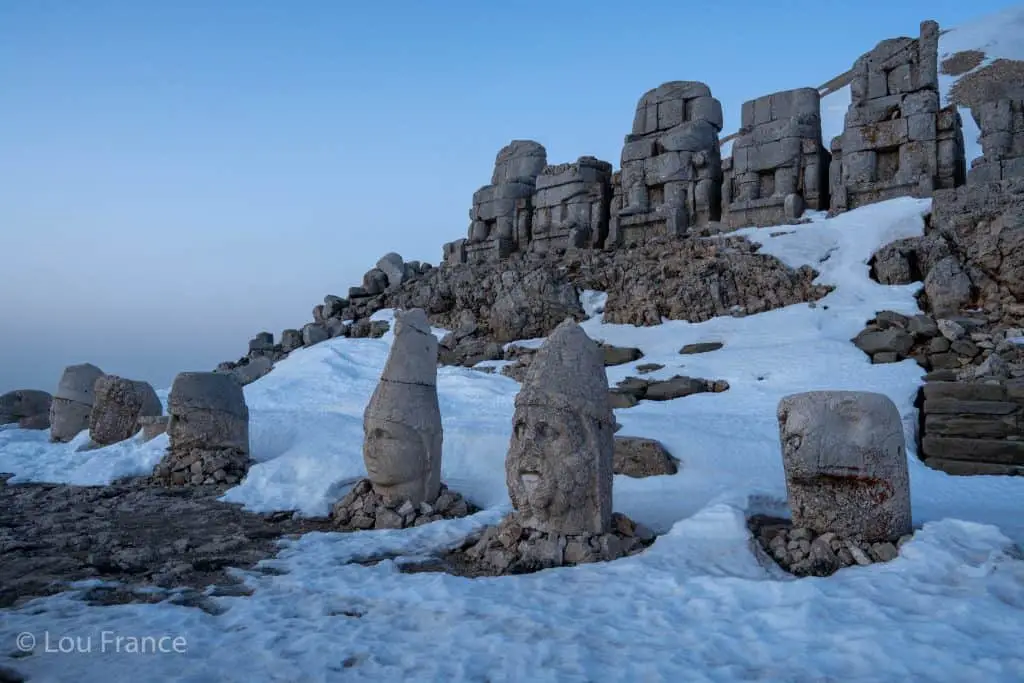
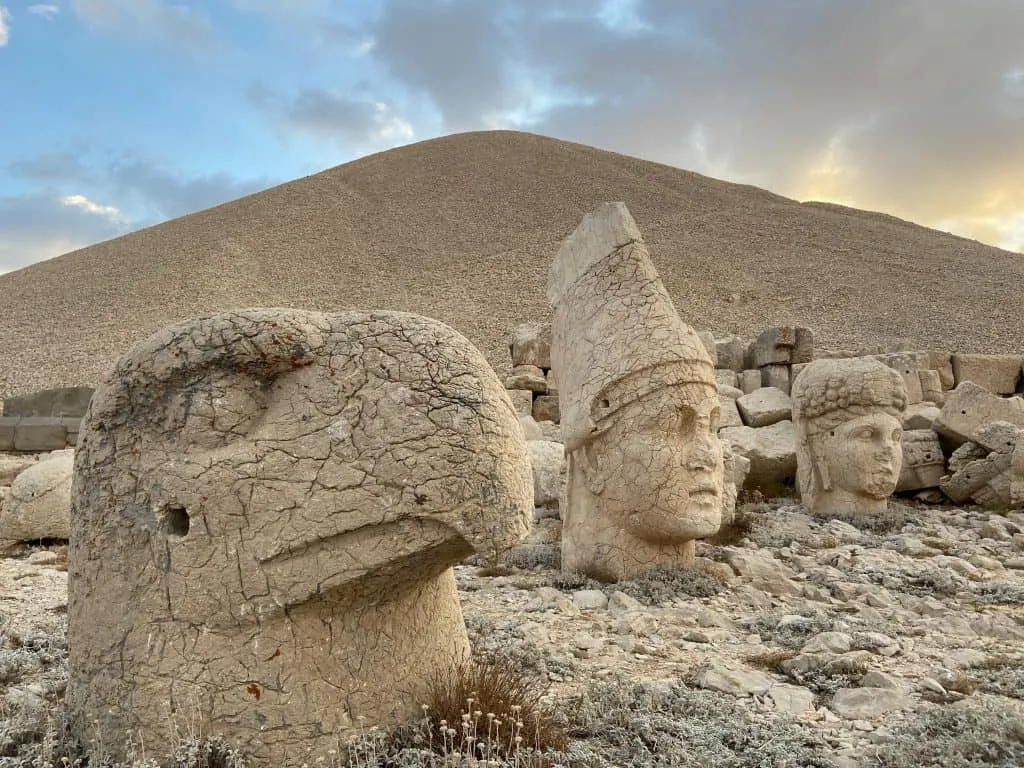
14. Aspendos
The Theatre of Dreams
Aspendos is an ancient city known for its well-preserved theatre. The theatre isn’t as large as some other sites in Turkey, such as Ephesus, but it is unique because it’s fully intact and provides amazing acoustics. There is a modern stage at the front of the theatre with regular performances of plays and concerts, including the incredible Fire of Anatolia Dance Show.
However, there is more to see at this site than just the theatre, with remains of a basilica, nymphauem, acropolis and citadel to explore. There is also an aqueduct located a short drive from the main site. For a great view of the theatre as a whole, follow the footpath up the hill just behind it. This also provides views over the surrounding region.
Located in the Antalya province, you can visit Aspendos on a guided tour from Antalya.
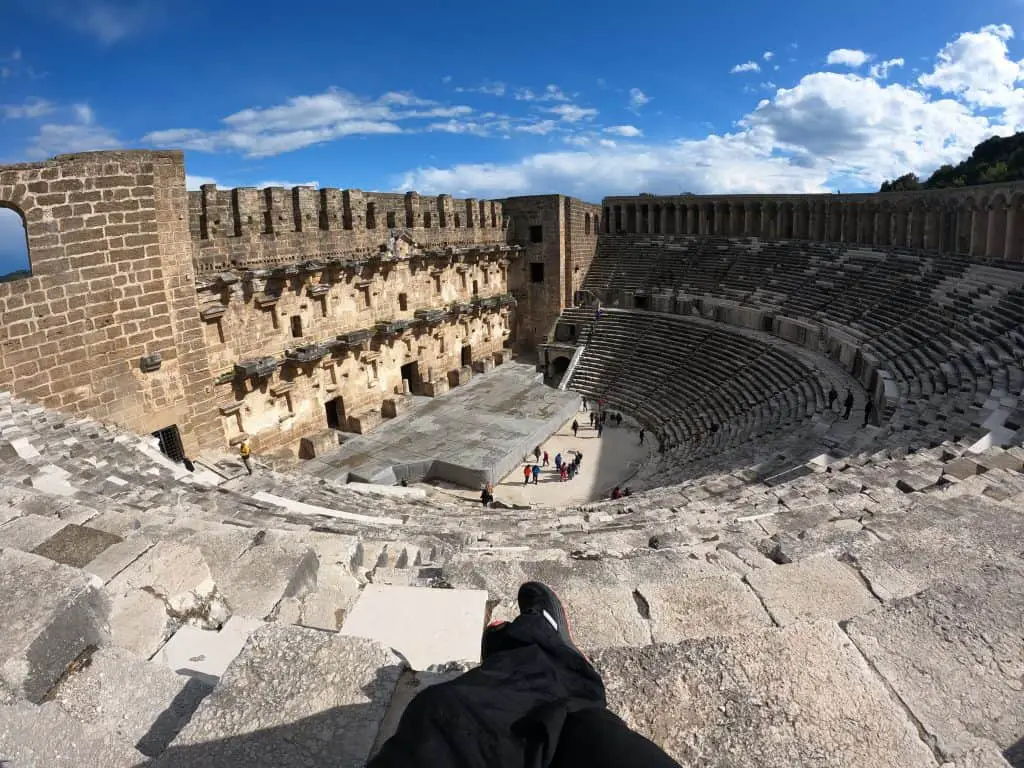
15. Thermessos
The Remote One
Thermessos is an ancient city located in the Taurus Mountains. This remote site lies partially in ruin, with nature claiming back the rubble that has been left abandoned. A short hike up the hillside is required to visit the main part of Thermessos, so an average level of fitness is required to reach this site. Sights to see here include a theatre, an agora, and a necropolis.
The theatre lies partially in ruin however the location is incredible. It sits at the top of a hill overlooking the beautiful landscape of the Taurus Mountains. It’s location is perhaps the reason why this city was never captured by Alexander the Great and the remote feeling is part of the attraction of this ancient city in Turkey.
The paths around Thermessos are signposted but they’re not always clear to follow. I used maps.me to help with navigation and had to help a few lost tourists along the way!
Thermessos is located in the Antalya province in southern Turkey and can be visited on a half day trip from Antalya.
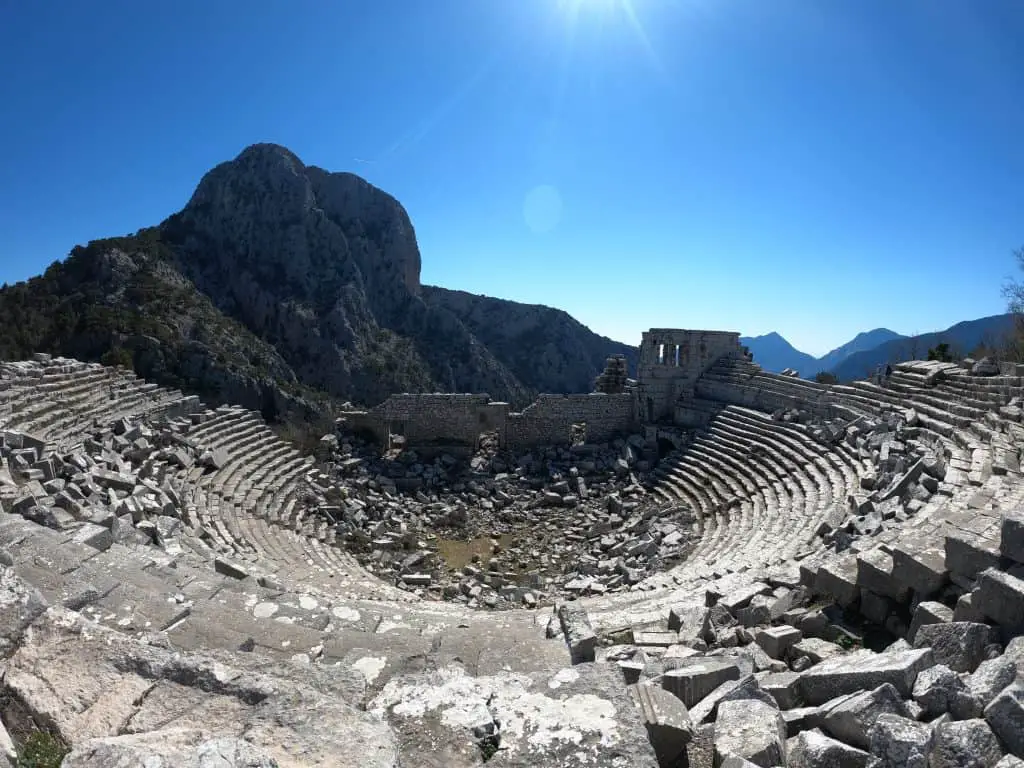
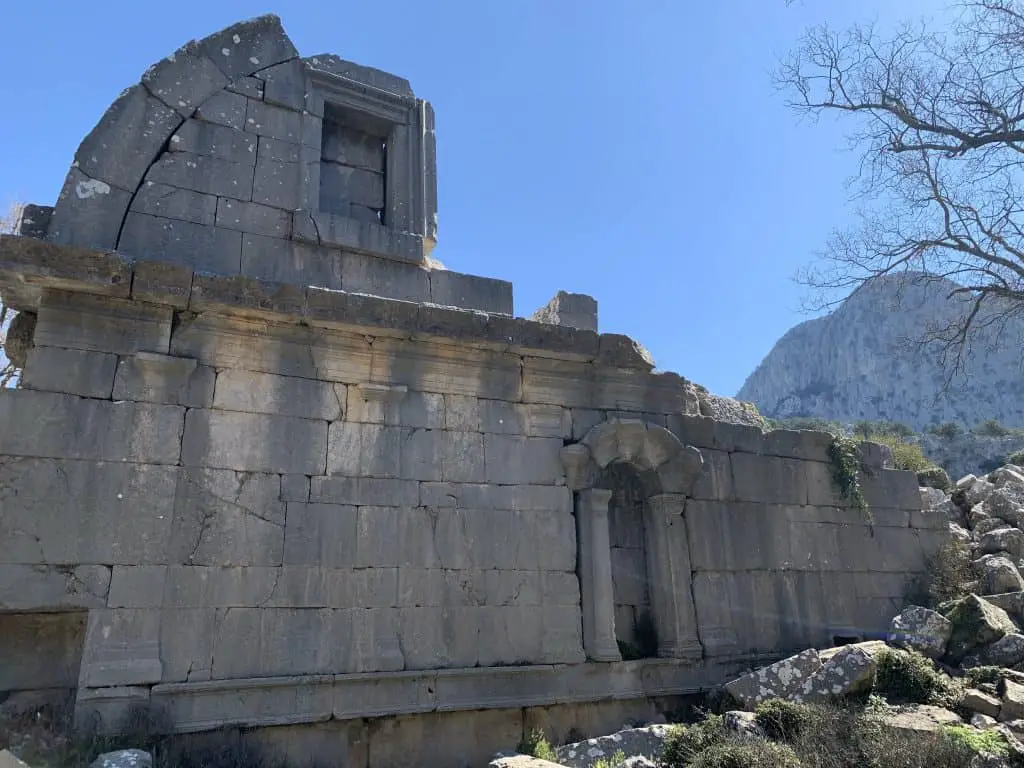
16. Ani
A Silk Road Legend
Situated near the Armenian border in eastern Turkey lies the historic city of Ani. Ani was once one of the largest cities in the world and a bustling commercial centre along the ancient Silk Road. Although technically not ancient, it’s historical importance mean I had to sneak it into this list!
Although much that remains lies in tatters, this ruined ghost city was inscribed as a UNESCO World Heritage Site in 2016, no doubt thanks to its massive historical importance. Ani was chosen as the new capital city by Armenian King Bagratid Ashot III in 961. It was later ruled by the Byzantines, Seljuks and Mongols until the great earthquake of 1319 destroyed most of the city.
Although not easy to visit, a trip to this remote region offers an eerily mesmerising experience and a chance to get off the beaten track in Turkey. This sprawling site is home to a cathedral, several churches, a karavanseray, mosque and Zoroastrian Fire Temple, demonstrating the city’s complex history.
Ani is located is the Kars Province of eastern Turkey.
→Ani
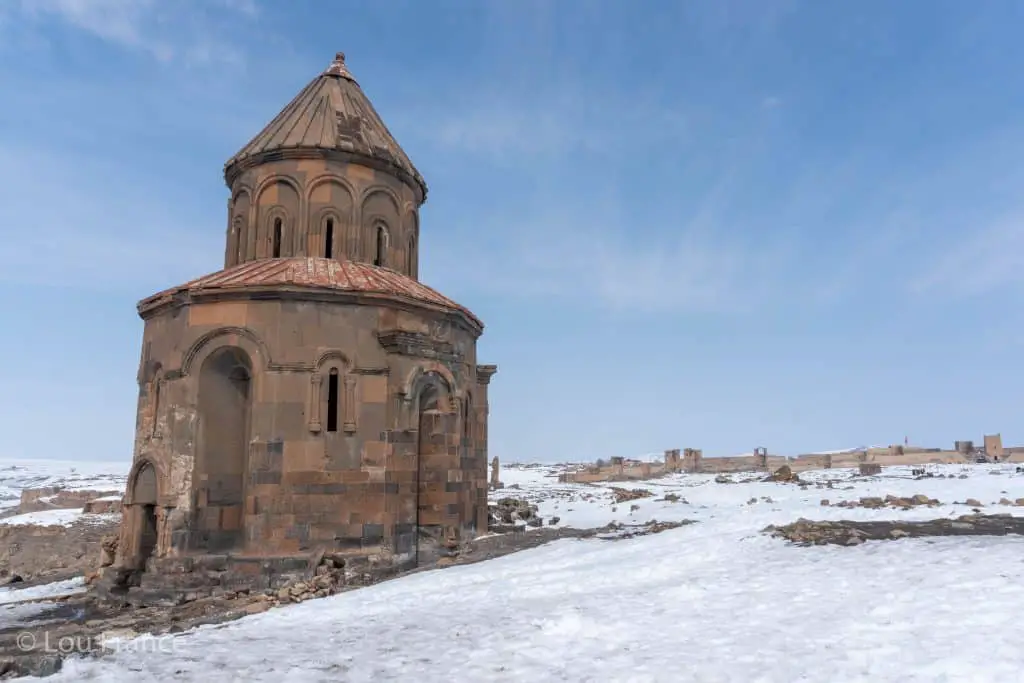
17. Myra
Rock-cut Tombs and Santa Claus
Myra is an ancient city that boasts a mesmerising collection of Lycian rock-cut tombs. Carved into the cliff faces, these tombs showcase intricate architectural details and offer a poignant reminder of the city’s past.
There are many rock-cut tombs to explore along the Turquoise Coast of Turkey, including those at Dalyan and the large Amyntas tomb in Fethiye old town. However the intricacy of the carvings at Myra are well worth their inclusion on this list, many of which are still impressively intact.
However Myra has more to see that just tombs. There is also a large amphitheatre which is in fine condition, including intact entrance corridors which date back to the Byzantine era. Myra is located near the modern day city of Demre. In the city itself you can also visit the Church of St Nicholas aka Santa Claus. This 9th century church is a place of pilgrimage for many Christians.
Demre has a fabulous Friday market with the fresh local produce, so try and plan your visit on this day if you want to experience an authentic Turkish market.
Myra is located in the Antalya Province near the town of Demre. Read more about visiting Demre in this guide.
→Myra
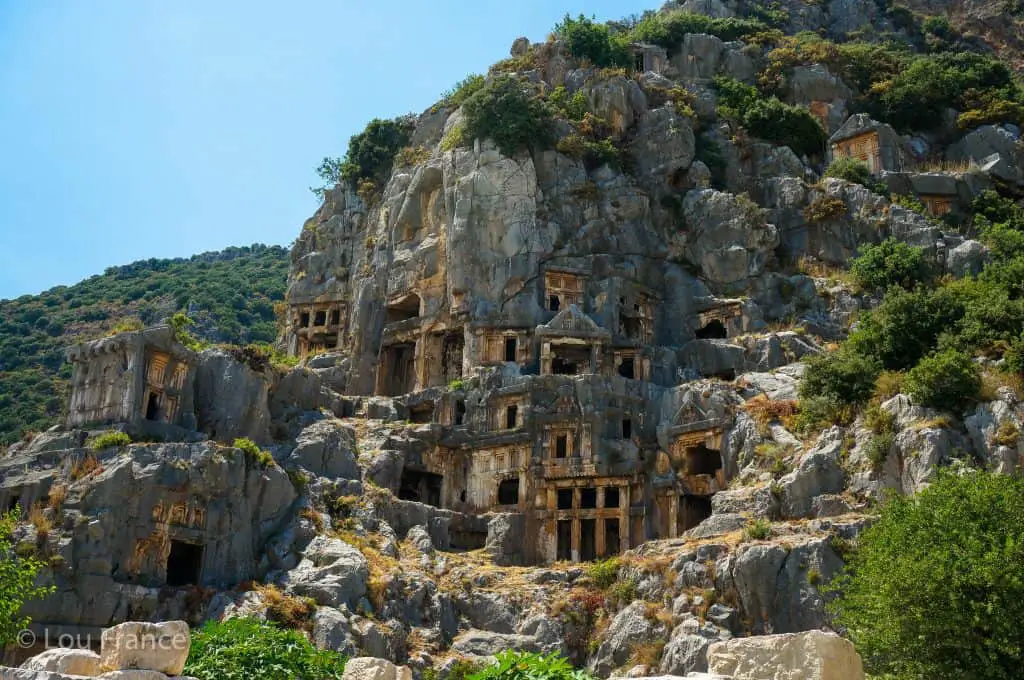
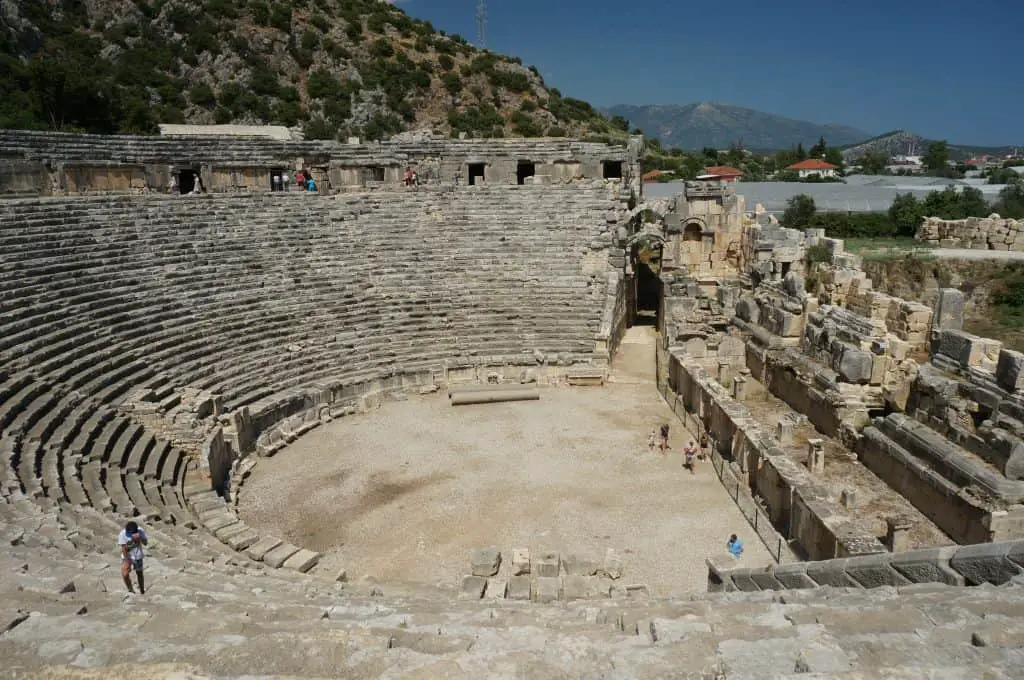
18. Dara
A True Hidden Gem Waiting to be Explored
Dara is a ruined ancient city southeast of Mardin. It was the last stronghold of the Byzantine Empire and an important trade centre of ancient Mesopotamia. Many people avoid visiting Dara due to its proximity to Syria, however this Turkish ruin is well worth exploring. Wandering around the deserted ruins, nestled side by side with the new village, makes for a very unique experience.
When arriving in Dara you will first see the necropolis with rock cut tombs, including a cave tomb complete with large amounts of human bones. An entrance fee is required for this impressive section of the city. The bus tours stop here but it is well worth venturing further into the village to explore the roman bridges, city walls, agora, water channels and even part of the Silk Road itself.
The stand out site in Dara for me is the vast water cistern which sits underneath the house of a local resident. It is certainly comparable to the Basilica cisterns found in Istanbul but this site you’re likely to have all to yourself, if you arrive before the tour groups.
Discover more hidden gems of Turkey in this guide.
Dara is located in the province of Mardin, in southeastern Turkey.
→Dara
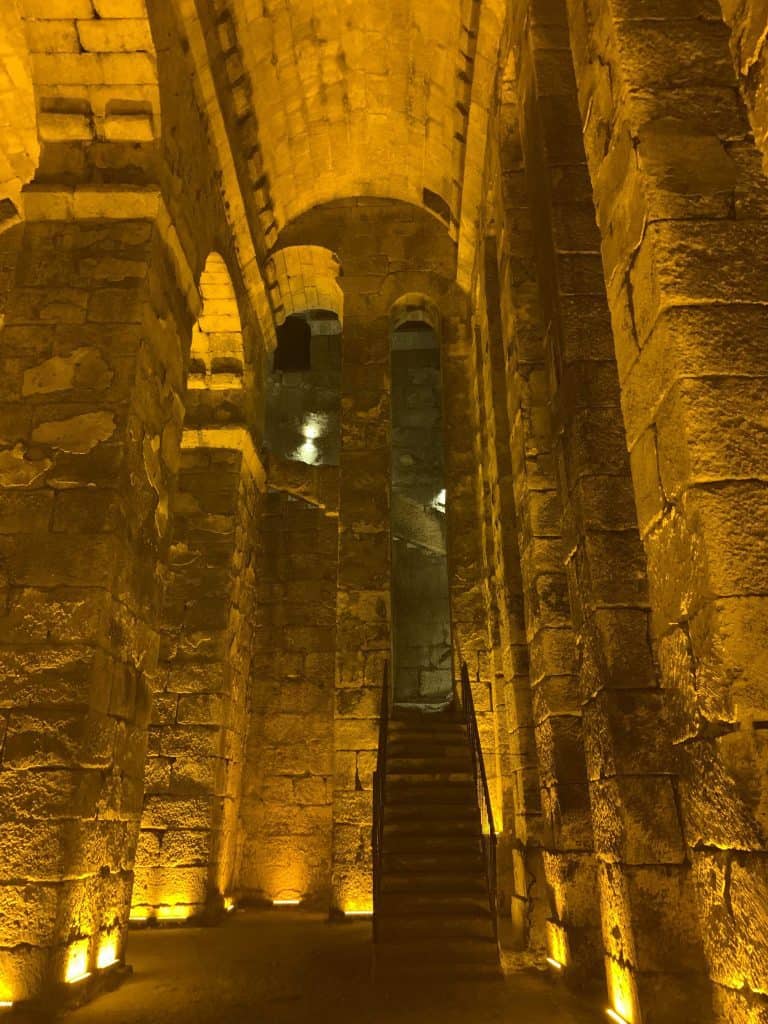
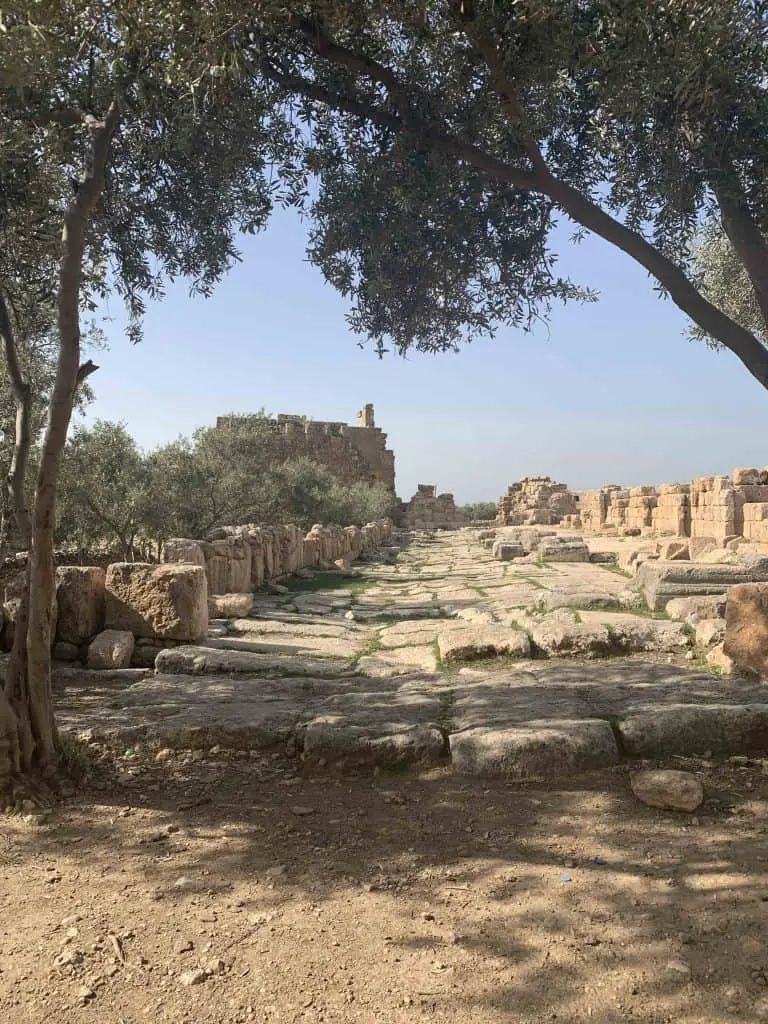
19. Anazarva
Escape the Crowds
Anazarva, also known as Anazarbus, is a ruined Roman era city found amongst the village of Dilekkaya in Southern Turkey. Next to the village you can find an impressive entrance gate leading to the remains of colonnaded street and amongst the fields, with a little exploring, you can find sections of a Roman era aqueduct.
However, perhaps the most impressive part of this ancient Turkish ruin is a fortress that runs atop the length of a nearby ridge. There are several ruined buildings worth exploring at Anazarva Castle which can be accessed by climbing up the hill from the ruined Byzantine church.
Your efforts will also be rewarded with long reaching views of the plains in either direction, making it a great spot for enjoying sunset. The battlements snake their way the length of the hill in either direction which are reminiscent of the Great Wall of China.
Anazarva is located in the Adana province, close to the gastronomy city of Gaziantep.

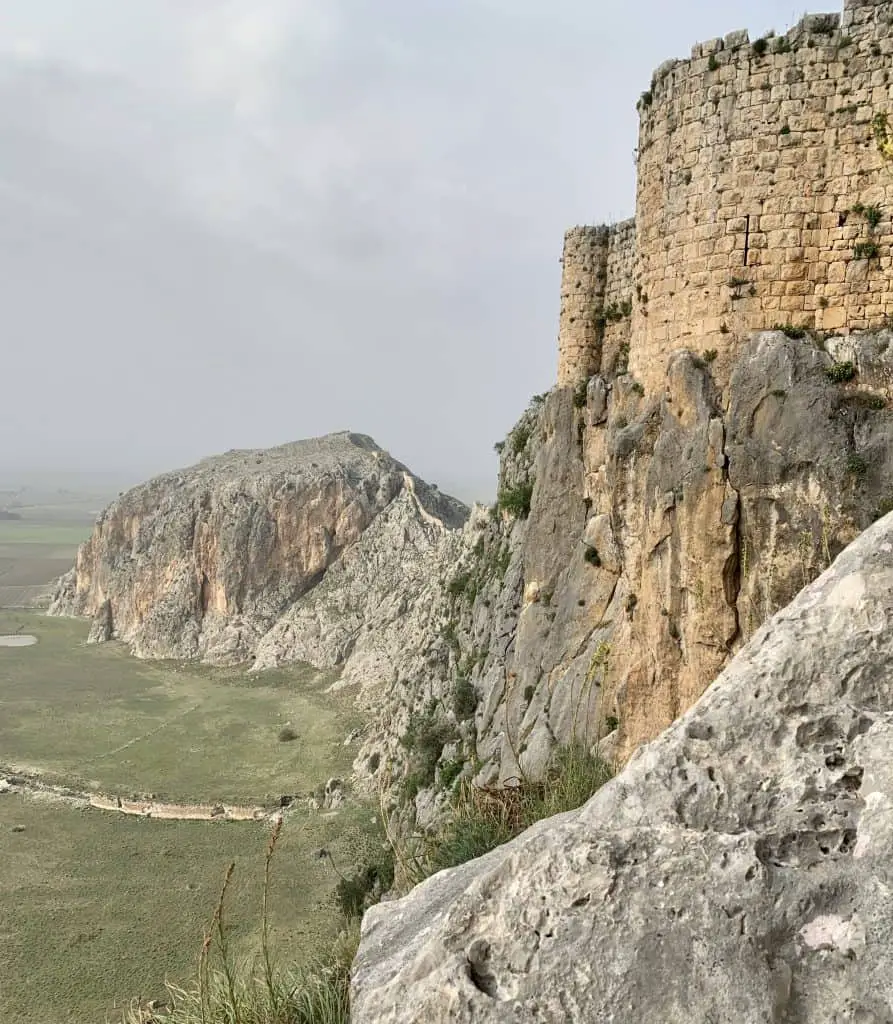
20. Van Castle
The Oldest Castle in Turkey
On the eastern shore of the saltwater Lake Van (Van Gölü), sits Van city. Dominating the modern city is the formidable fortress of Van Castle. The castle dates back to the 7th-9th centuries BC and the Kingdom of Urartu, whose empire controlled much of the region.
Whilst the castle is very much in ruin, a short hike to the top of this ancient fortress provides fabulous views over lake Van and the city below. The castles stretches over 1km in length atop a natural rocky outcrop. The remains of the castle walls today mostly date back to the Ottoman period however there are a few Urartian tombs and temples.
Situated at the foot of the fortress hill you can find the very modern Van Museum which explains the complicated history of this area.
Van Castle is located in the Province of Van in eastern Turkey.
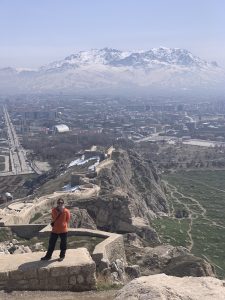
21. Aphrodisias
The City of Love
Dedicated to the goddess of love, Aphrodite, Aphrodisias is a captivating archaeological site that will transport you back to the glory days of the Roman Empire. Aphrodisias is arguably the best preserved Greco-Roman ruin in Turkey.
Admire the exquisite marble sculptures and architecture, such as the Tetrapylon gate and stroll through the enormous stadium, the largest in the ancient world. You can also explore the elaborate Roman baths and well-preserved theatre.
The Aphrodisias Museum, located on-site, houses an extensive collection of sculptures that showcase the unparalleled craftsmanship of ancient artisans.
Aphrodisias is located is the Aydin Province in western Anatolia.
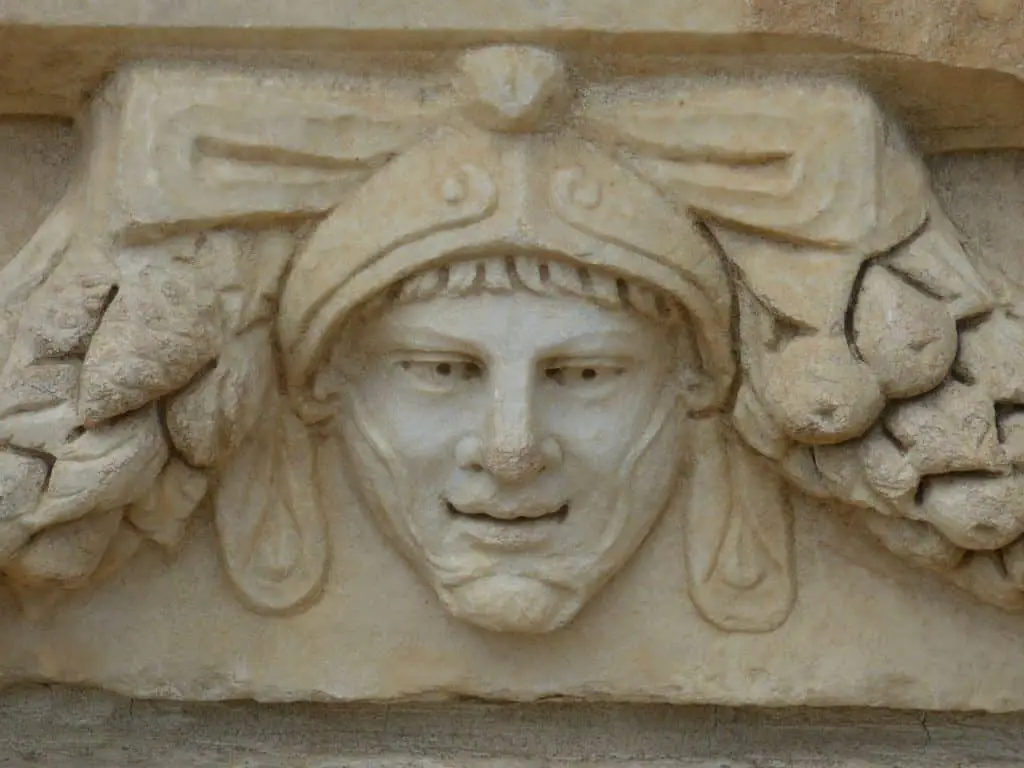
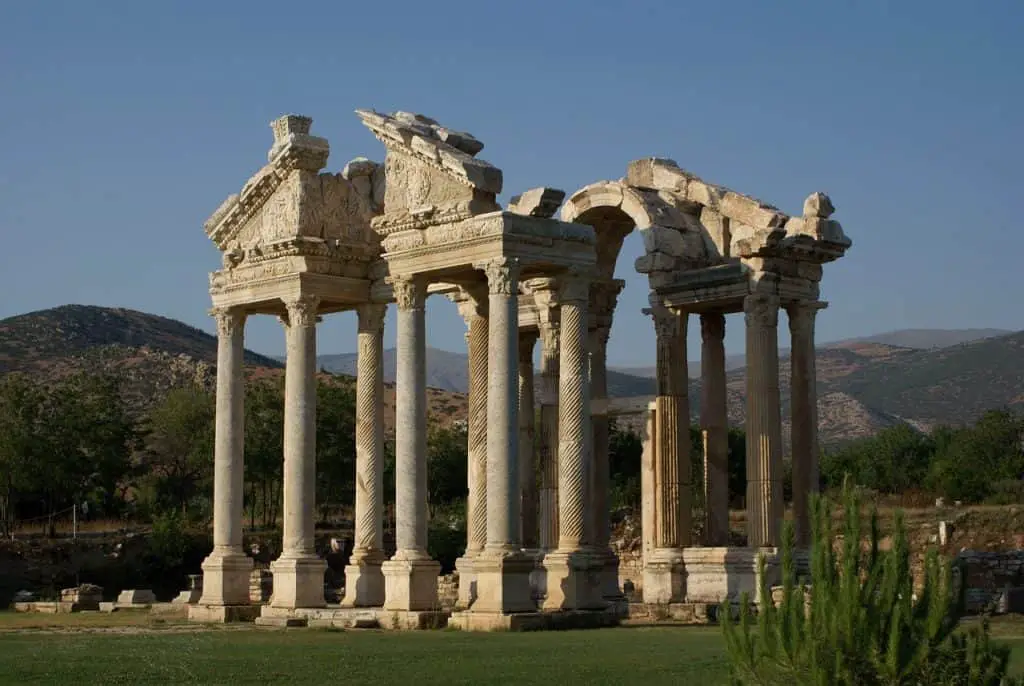
Final Thoughts on the Best Archaeological Ruins in Turkey
Turkey is a country steeped in history, boasting a rich tapestry of ancient civilisations and archaeological wonders. From the majestic ruins of Ephesus to the legend of Troy, this land has captivated travellers for centuries.
In this article, I described 21 of the best ancient historical sites to visit in Turkey, immersing you in the fascinating stories and architectural marvels that await. This list is by no means exhaustive and there are certainly many more places that could be added, but hopefully this guide has given you a good place to start.
Join My Newsletter Today!
